9. Practical application of a elinear motorf type rail brake
- A contactless rail brake which can also be used during power outages was developed.
- A prototype of the brake was fitted to a commercial line vehicle bogie to verify that the target braking force could be reached without a power supply.
An eddy current rail brake functions using a phenomenon called electromagnetic induction, which generates an eddy current in rails. The braking force is generated from the magnetic force created between the rail and the brake. The developed elinear motorf type rail brake has the advantages of being contactless with the rail, that it can be used when a feeder circuit malfunctions and does not increase temperature of the rail as much as conventional eddy current rail brakes. Stationary tests on a roller rig were carried out to determine its thermal and electromagnetic characteristics for speeds up to 300 km/h. Results demonstrated that in practice it met with design criteria.
A prototype of the elinear motorf type rail brake was fitted to a railway vehicle bogie (Fig.1) and yard running tests were carried out, showing that actual braking force and power generating performance correlated well with design values and forecasts obtained from the roller rig stationary tests (Fig.2). The performance of the brake using an auxiliary circuit and self-generated power during a feeder circuit malfunction was also verified.
The characteristics of the newly developed equipment should make it possible to achieve several targets, namely, producing a braking force of 10kN on each bogie, ability to function while relying on self-generated power having been cut off from the main circuit and possibility of increasing wheel load, that has a positive effect on adhesive force, due to magnetic attractive force in addition to vehicle load. The braking force of this device is notably greater at higher speeds suggesting that it could supplement the decrease in adhesive force at high speed on vehicles such as Shinkansen trains or express trains running on meter-gauge railway lines.

Fig.1 eLinear motorf type rail brake fitted to vehicle bogie
Fig.2 Brake force characteristics
(for each side (left/right) of the bogie)